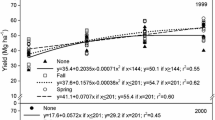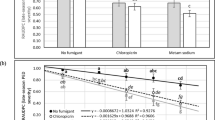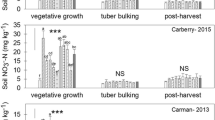Abstract
The availability and use of crop protectants including azoxystrobin in combination with fumigation has extended the Central Wisconsin effective growing season by 2 to 4 weeks. This study, evaluating the influence of these crop protection practices on the optimum nitrogen rate and time of application for Russet Burbank potato (Solanum tuberosum L.), was established as two 3-year field trials designed as split-split plot experiments. Both experiments used metam sodium as the main plots and fungicide treatment (chlorothalonil Zn alone or chlorothalonil Zn alternated with azoxystrobin for the first six sprays) as the first split. In-season fertilizer N rate (179, 224, 269, or 313 kg N ha−1) or in-season N timing (N split into two, three, or four applications at 269 kg N ha−1) was the second split. Not fumigating resulted in significantly higher verticillium ratings and severely repressed crop yield and tuber quality responses to both fungicide treatment and N rate. On average, fumigation increased total yield 13.6 Mg ha−1yr−1, U.S. No. 1 tubers by 9 % and U.S. No. 1 tubers >170 g by 5 % over where fumigation was not used. In 2 of the 3 years when azoxystrobin was included in the fungicide program early blight severity was reduced by about 50 %, and on fumigated areas yields were increased 4.8 Mg ha−1, whereas no yield increase was seen from this fungicide treatment on the non-fumigated plots. In these same years, fumigation increased optimum N rate by about 50 kg ha−1; however, there was no apparent interaction with fungicide treatment. Although fumigation, fungicide treatment, and time of N application each influenced tuber yield or tuber quality in some years, in the two more responsive years some interactions between these factors were statistically significant, with benefits generally only seen where plots were fumigated.
Resumen
La disponibilidad y uso de protectores del cultivo, incluyendo azoxistrobina en combinación con fumigación, ha extendido efectivamente el ciclo de cultivo por 2 a 4 semanas en el centro de Wisconsin. Este estudio, evaluando la influencia de estas prácticas de protección del cultivo en el nivel óptimo de nitrógeno y tiempo de aplicación para la papa Russet Burbank (Solanum tuberosum L.), se estableció como dos ensayos de campo de tres años diseñados como experimentos de parcelas subdivididas. En ambos experimentos se usó metam-sodio como la parcela principal, y el tratamiento con el fungicida (clorotalonil-Zn solo o clorotalonil-Zn alternado con azoxistrobina en las primeras seis aspersiones) como la primera división. En el ciclo el nivel de fertilización nitrogenada (179, 224, 269, o 313 kg N ha-1), o tiempos de aplicación (el N dividido en dos, tres o cuatro aplicaciones de 269 kg N ha-1) como la segunda división. La no fumigación dio como resultado niveles significativamente altos de Verticillium y rendimiento del cultivo severamente disminuido, así como en las respuestas en la calidad de tubérculo a ambos tratamientos de fungicida y de nivel de N. En promedio, la fumigación aumentó el rendimiento total 13.6 Mg ha-1 año 1, tubérculos US 1 en 9 %, y tubérculos US 1 > 170 g en 5 % sobre aquellos en donde no se usó fumigación. En dos de los tres años, cuando se incluyó azoxistrobina en el programa de fungicidas, la severidad del tizón temprano se redujo en carca del 50 %, y en las áreas fumigadas los rendimientos aumentaron 4.8 Mg ha-1, mientras que no se observó aumento en el rendimiento de este tratamiento de fungicida en los lotes no fumigados. En estos mismos años, la fumigación aumentó el nivel óptimo de N en cerca de 50 kg ha-1; no obstante, no hubo interacción aparente con el tratamiento del fungicida. Aun cuando la fumigación, el tratamiento con fungicida, y el tiempo de aplicación del N cada uno influenció el rendimiento y la calidad de tubérculo en algunos años, en los dos años de mayor respuesta, algunas de las interacciones entre estos factores fueron estadísticamente significativas, con beneficios generalmente observados solamente donde se fumigaron los lotes.

Similar content being viewed by others
References
Barclay, G.M., H.J. Murphy, F.E. Manzer, and F.E. Hutchinson. 1973. Effects of differential rates of nitrogen and phosphorus on early blight in potatoes. American Potato Journal 60: 42–48.
Ben-Yephet, Y., E. Siti, and Z. Frank. 1983. Control of Verticillium dahliae by metam sodium in loessial soil and effect on potato tuber yields. Plant Disease 67: 1223–1225.
Cao, W., and T.W. Tibbitts. 1993. Study of various NH4 +/NO3 – mixtures for enhancing growth of potatoes. Journal of Plant Nutrition 16: 1691–1704.
Collins, H.P., A. Alva, R.A. Boydston, R.L. Cochran, P.B. Hamm, A. McGuire, and E. Riga. 2006. Soil microbial, fungal, and nematode responses to soil fumigation and cover crops under potato production. Biology and Fertility of Soils 42: 247–257.
Davis, J.M., W.H. Loescher, M.W. Hammond, and R.E. Thornton. 1986. Response of Russet Burbank potatoes to soil fumigation and nitrogen fertilizers. American Potato Journal 63: 71–79.
Davis, J.R. 1985. Approaches to control of potato early dying caused by Verticillium dahliae. American Potato Journal 62: 177–185.
Davis, J.R., and D.O. Everson. 1986. Relationship of Verticillium dahliae in soil and plant tissue, irrigation method, and N fertility to verticillium wilt of potato. Phytopathology 76: 730–736.
Davis, J.R., and O.C. Huisman. 2001. Verticillium wilt. In Compendium of potato diseases, 2nd ed, ed. W.R. Stevenson, R. Loria, G.D. Franc, and D.P. Weingartner, 45–46. St. Paul: APS Press.
Davis, J.R., L.H. Sorenson, J.C. Stark, and D.T. Westermann. 1990. Fertility and management practices to control verticillium wilt of the Russet Burbank potato. American Potato Journal 67: 55–65.
Davis, J.R., J.C. Stark, L.H. Sorenson, and A.T. Schneider. 1994. Interactive effects of nitrogen and phosphorus on verticillium wilt of Russet Burbank potato. American Potato Journal 71: 467–481.
Franc, G.D., and B.J. Christ. 2001. Early blight. In Compendium of potato diseases, 2nd ed, ed. W.R. Stevenson, R. Loria, G.D. Franc, and D.P. Weingartner, 22–23. St. Paul: APS Press.
Hendrickson, L.L., D.R. Keeney, L.M. Walsh, and E.A. Liegel. 1978. Evaluation of nitrapyrin as a means of improving N efficiency in irrigated sands. Agronomy Journal 70: 699–703.
Horsfall, J.G., and R.W. Barratt. 1945. An improved grading system for measuring plant diseases. Phytopathology 35: 655.
Huber, D.M., and R.D. Watson. 1974. Nitrogen form and plant disease. Annual Review of Phytopathology 12: 139–165.
Ibekwe, A.M., S.K. Papiernick, J. Gan, S.R. Yates, and D.E. Crowley. 2001. Impact of soil fumigants on soil microbial communities. Applied Environmental Microbiology 67: 3245–3257.
Kelling, K.A. 2000. Research observations on petiole nitrate testing. Proceedings of the Annual Wisconsin Potato Meetings 13: 175–184.
Kelling, K.A., and P.E. Speth. 1998. Timing of nitrogen application on potatoes. Proceedings of the Annual Wisconsin Potato Meetings 11: 61–72.
Kelling, K.A., R.P. Wolkowski, and M.D. Ruark. 2011. Potato response to nitrogen form and nitrification inhibitors. American Journal of Potato Research 88: 459–469.
Kelling, K.A., F.J. Arriaga, B. Lowery, M.O. Jordan, and P.E. Speth. 2015. Use of hill shape with various nitrogen timing splits to improve fertilizer use efficiency. American Journal of Potato Research 92: 71–78.
Kleinschmidt, G.D., G.E. Kleinkopf, D.T. Westermann, and J.C. Zalewski. 1984. Specific gravity of potatoes. Current Information Series No. 609, University of Idaho.
Koike, H. 1961. The effects of fumigants on nitrate production in soil. Proceedings of the Soil Science Society of America 25: 204–206.
Lachat Instruments. 1992. Total Kjeldahl nitrogen in soil/plants. Quikchem method 13-107-06-02-D. User Manual, Lachat Instruments, Mequon, Wisconsin.
Lachat Instruments. 1996. Nitrate in water extracts. QuikChem method 12-101-04-1-B. User Manual, Lachat Instruments, Mequon, Wisconsin.
Lambert, D.H., M.L. Powelson, and W.R. Stevenson. 2005. Nutritional interactions influencing diseases of potato. American Journal of Potato Research 82: 309–319.
Lazarovits, G. 2010. Managing soil borne disease of potatoes using ecologically based approaches. American Journal of Potato Research 87: 401–411.
Lazarovits, G., K. Cohn, and M. Tenuta. 1997. Control of Verticillium dahliae with soil amendments: Efficacy and mode of action. In Advances in Verticillium research and disease, ed. E.C. Tjamos, R.C. Rowe, J.B. Heale, and D.R. Fravel, 274–291. Athens, Greece: Proceedings of the Seventh International Verticillium Symposium.
Macalady, J.L., M.E. Fuller, and K.M. Scow. 1998. Effects of metam sodium fumigation on microbial activity and community structure. Journal of Environmental Quality 27: 54–63.
MacKenzie, D.R. 1981. Association of potato early blight, nitrogen fertilizer rate, and potato yield. Plant Diseases 65: 575–577.
Marshall-Farrar, K.D., M. McGrath, R.V. James, and W.R. Stevenson. 1998. Characterization of Phytophthora infestans in Wisconsin from 1993 to 1995. Plant Disease 82: 434–436.
Miller, J.S., and C.J. Rosen. 2005. Interactive effects of fungicide programs and nitrogen management on potato yield and quality. American Journal of Potato Research 82: 399–409.
Molina, O.I., M. Tenuta, A. El-Hadrami, K. Buckley, C. Cavers, and F. Daayf. 2014. Potato early dying and yield responses to compost, green manures, seed meal and chemical treatments. American Journal of Potato Research 91: 414–428.
Nelson, D.W., and L.E. Sommers. 1973. Determination of total nitrogen in plant material. Agronomy Journal 65: 109–112.
O’Sullivan, J.O., and A.A. Reyes. 1980. Effects of soil fumigation, rotation and nitrogen on yield, petiole NO3-N and verticillium wilt of potatoes. Journal of the American Society for Horticultural Science 105(6): 809–812.
Pennypacker, B.W. 1989. The role of mineral nutrition on the control of verticillium wilt. In Soil borne plant pathogens: Management of diseases with macro- and micro-elements, ed. A.W. Engelhard, 33–45. St. Paul: APS Press.
Platt, H.W., and W.J. Arsenault. 2001. Management of nitrogen and phosphorus rates does not suppress verticillium wilt in Yukon Gold. American Journal of Potato Research 78: 215–219.
Polizotto, K.R., G.E. Wilcox, and E.J. Jones. 1975. Response of growth and mineral composition of potato to nitrate and ammonium nitrogen. Journal of the American Society for Horticultural Science 100: 165–168.
Powelson, R.L., and G.E. Carter. 1973. Efficacy of soil fumigants for control of verticillium wilt of potatoes. American Potato Journal 50: 162–167.
Rowe, R.C., and M.L. Powelson. 2002. Potato early dying: Management challenges in a changing production environment. Plant Disease 86: 1184–1193.
SAS (Statistical Analysis System Institute). 1999. SAS User’s Guide, Version 8.0. Statistical Analysis Systems Institute, Cary, North Carolina.
Soltanpour, P.N., and M.D. Harrison. 1974. Interrelations between nitrogen and phosphorus fertilization and early blight control of potatoes. American Potato Journal 51: 1–7.
Starr, G.C., E.T. Cooley, B. Lowery, and K.A. Kelling. 2005. Soil water fluctuations in loamy sand under irrigated potato. Soil Science 170: 77–89.
Stevenson, W.R. 2001. Potato disease management – one step forward and two steps back. Proceedings of the Annual Wisconsin Potato Meetings 14: 175–213.
Stevenson, W.R., R.V. James, and R.E. Rand. 1999. When and how to use early blight and late blight fungicides. Proceedings of the Annual Wisconsin Potato Meetings 12: 227–280.
Tanner, C.B., G.G. Weis, and D. Curwen. 1982. Russet Burbank rooting in sandy soils with pans following deep plowing. American Potato Journal 59: 107–112.
Tsror, L., E. Shlevin, and I. Peretz-Alon. 2005. Efficacy of metam-sodium for controlling Verticillium dahliae prior to potato production in sandy soils. American Journal of Potato Research 82: 419–423.
United States Department of Agriculture. 1964. Determining solids in potatoes. Agricultural Handbook no. 267. U.S. Government Printing Office, Washington, DC.
Wolcott, A.R., F. Maciak, L.N. Shepherd, and R.E. Lucas. 1960. Effects of Telone on nitrogen transformations and on growth of celery in organic soil. Down to Earth 16: 10–14.
Acknowledgments
Support for portions of this research was provided by the Wisconsin Potato and Vegetable Growers Association Potato Industry Board, the Wisconsin Fertilizer Research Council, and UW College of Agricultural and Life Sciences, and is gratefully acknowledged.
Author information
Authors and Affiliations
Corresponding author
Rights and permissions
About this article
Cite this article
Kelling, K.A., Stevenson, W.R., Speth, P.E. et al. Interactive Effects of Fumigation and Fungicides on Potato Response to Nitrogen Rate or Timing. Am. J. Potato Res. 93, 533–542 (2016). https://doi.org/10.1007/s12230-016-9532-6
Published:
Issue Date:
DOI: https://doi.org/10.1007/s12230-016-9532-6




